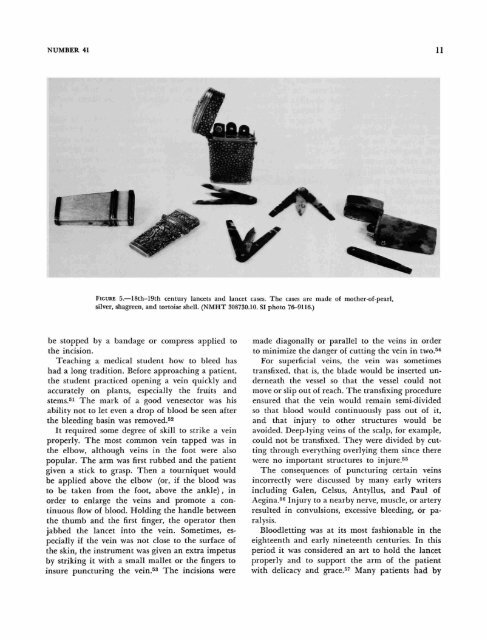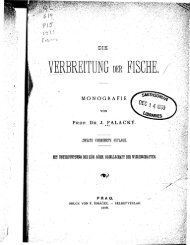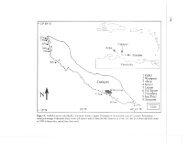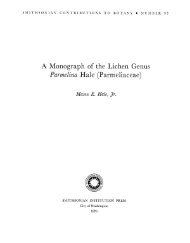BLOODLETTING INSTRUMENTS - Smithsonian Institution Libraries
BLOODLETTING INSTRUMENTS - Smithsonian Institution Libraries
BLOODLETTING INSTRUMENTS - Smithsonian Institution Libraries
You also want an ePaper? Increase the reach of your titles
YUMPU automatically turns print PDFs into web optimized ePapers that Google loves.
NUMBER 41 11<br />
FIGURE 5.—18th-19th century lancets and lancet cases. The cases are made of mother-of-pearl,<br />
silver, shagreen, and tortoise shell. (NMHT 308730.10. SI photo 76-9116.)<br />
be Stopped by a bandage or compress applied to<br />
the incision.<br />
Teaching a medical student how to bleed has<br />
had a long tradition. Before approaching a patient,<br />
the student practiced opening a vein quickly and<br />
accurately on plants, especially the fruits and<br />
stems.^i The mark of a good venesector was his<br />
ability not to let even a drop of blood be seen after<br />
the bleeding basin was removed.^^<br />
It required some degree of skill to strike a vein<br />
properly. The most common vein tapped was in<br />
the elbow, although veins in the foot were also<br />
popular. The arm was first rubbed and the patient<br />
given a stick to grasp. Then a tourniquet would<br />
be applied above the elbow (or, if the blood was<br />
to be taken from the foot, above the ankle), in<br />
order to enlarge the veins and promote a continuous<br />
flow of blood. Holding the handle between<br />
the thumb and the first finger, the operator then<br />
jabbed the lancet into the vein. Sometimes, especially<br />
if the vein was not close to the surface of<br />
the skin, the instrument was given an extra impetus<br />
by striking it with a small mallet or the fingers to<br />
insure puncturing the vein.^^ xhe incisions were<br />
made diagonally or parallel to the veins in order<br />
to minimize the danger of cutting the vein in two.^*<br />
For superficial veins, the vein was sometimes<br />
transfixed, that is, the blade would be inserted underneath<br />
the vessel so that the vessel could not<br />
move or slip out of reach. The transfixing procedure<br />
ensured that the vein would remain semi-divided<br />
so that blood would continuously pass out of it,<br />
and that injury to other structures would be<br />
avoided. Deeplying veins of the scalp, for example,<br />
could not be transfixed. They were divided by cutting<br />
through everything overlying them since there<br />
were no important structures to injure.^^<br />
The consequences of puncturing certain veins<br />
incorrectly were discussed by many early writers<br />
including Galen, Celsus, Antyllus, and Paul of<br />
Aegina.^^ Injury to a nearby nerve, muscle, or artery<br />
resulted in convulsions, excessive bleeding, or paralysis.<br />
Bloodletting was at its most fashionable in the<br />
eighteenth and early nineteenth centuries. In this<br />
period it was considered an art to hold the lancet<br />
properly and to support the arm of the patient<br />
with delicacy and grace.^^ Many patients had by
















